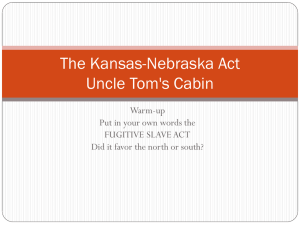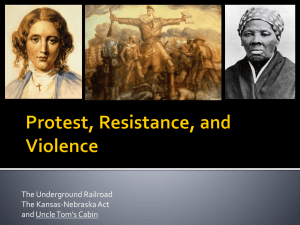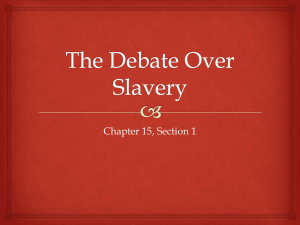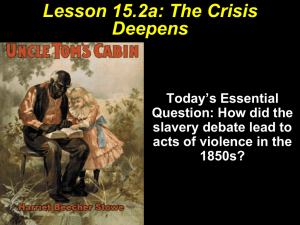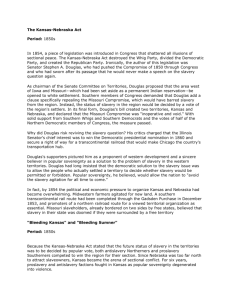The Crisis Deepens
advertisement
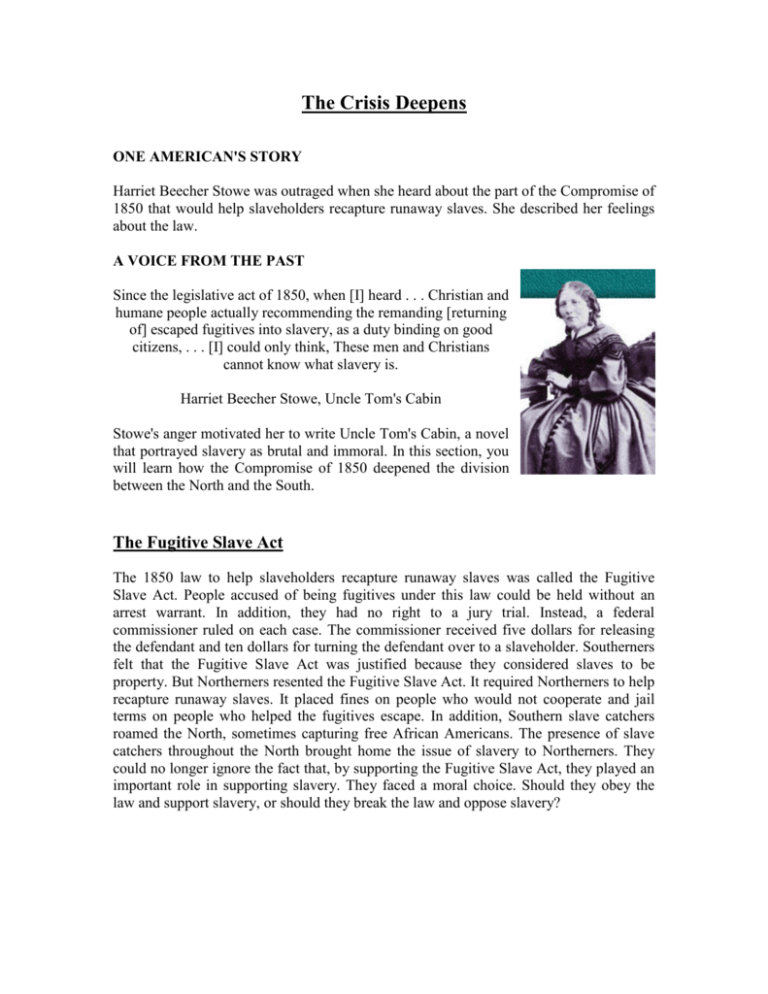
The Crisis Deepens ONE AMERICAN'S STORY Harriet Beecher Stowe was outraged when she heard about the part of the Compromise of 1850 that would help slaveholders recapture runaway slaves. She described her feelings about the law. A VOICE FROM THE PAST Since the legislative act of 1850, when [I] heard . . . Christian and humane people actually recommending the remanding [returning of] escaped fugitives into slavery, as a duty binding on good citizens, . . . [I] could only think, These men and Christians cannot know what slavery is. Harriet Beecher Stowe, Uncle Tom's Cabin Stowe's anger motivated her to write Uncle Tom's Cabin, a novel that portrayed slavery as brutal and immoral. In this section, you will learn how the Compromise of 1850 deepened the division between the North and the South. The Fugitive Slave Act The 1850 law to help slaveholders recapture runaway slaves was called the Fugitive Slave Act. People accused of being fugitives under this law could be held without an arrest warrant. In addition, they had no right to a jury trial. Instead, a federal commissioner ruled on each case. The commissioner received five dollars for releasing the defendant and ten dollars for turning the defendant over to a slaveholder. Southerners felt that the Fugitive Slave Act was justified because they considered slaves to be property. But Northerners resented the Fugitive Slave Act. It required Northerners to help recapture runaway slaves. It placed fines on people who would not cooperate and jail terms on people who helped the fugitives escape. In addition, Southern slave catchers roamed the North, sometimes capturing free African Americans. The presence of slave catchers throughout the North brought home the issue of slavery to Northerners. They could no longer ignore the fact that, by supporting the Fugitive Slave Act, they played an important role in supporting slavery. They faced a moral choice. Should they obey the law and support slavery, or should they break the law and oppose slavery? Uncle Tom's Cabin Stowe published Uncle Tom's Cabin in 1852. It dramatically portrayed the moral issues of slavery. In fact, a play based on the book increased the popularity of theater as well as abolitionism. The book's main character was Uncle Tom, a respected older slave. The plot centers on Tom's life under three owners. Two of the owners were kind, but the third was cruel. The novel includes dramatic scenes, such as the dangerous escape of a slave named Eliza and her baby across the Ohio River. Stowe's book was wildly popular in the North. But white Southerners believed the book falsely criticized the South and slavery. The Kansas-Nebraska Act While the Fugitive Slave Act and Uncle Tom's Cabin heightened the conflicts between the North and the South, the issue of slavery in the territories brought bloodshed to the West. In 1854, Senator Stephen A. Douglas of Illinois drafted a bill to organize territorial governments for the Nebraska Territory. He proposed that it be divided into two territories-Nebraska and Kansas. To get Southern support for the bill, he suggested that the decision about whether to allow slavery in each of these territories be settled by popular sovereignty. Popular sovereignty is a system where the residents vote to decide an issue. If this bill passed, it would result in getting rid of the Missouri Compromise by allowing people to vote for slavery in territories where the Missouri Compromise had banned it. As Douglas hoped, Southerners applauded the repeal of the Missouri Compromise and supported the bill. Even though the bill angered opponents of slavery, it passed. It became known as the Kansas-Nebraska Act. Few people realized that the act would soon turn Kansas into a battleground over slavery. "Bleeding Kansas" Proslavery and antislavery settlers rushed into the Kansas Territory, just west of Missouri, to vote for the territorial legislature. At the time of the election in March 1855, there were more proslavery settlers than antislavery settlers in the territory. But the proslavery forces did not want to risk losing the election. Five thousand Missourians came and voted in the election illegally. As a result, the official Kansas legislature was packed with proslavery representatives. Antislavery settlers boycotted the official government and formed a government of their own. With political authority in dispute, settlers on both sides armed themselves. In May, a proslavery mob attacked the town of Lawrence, Kansas. The attackers destroyed offices and the house of the governor of the antislavery government. This attack came to be known as the Sack of Lawrence. Onto this explosive scene came John Brown, an extreme abolitionist. To avenge the Sack of Lawrence, Brown and seven other men went to the cabins of several of his proslavery neighbors and murdered five people. This attack is known as the Pottawatomie Massacre, after the creek near where the victims were found. As news of the violence spread, civil war broke out in Kansas. It continued for three years, and the territory came to be called "Bleeding Kansas." Violence in Congress While violence was spreading in Kansas in the spring of 1856, blood was also being shed in the nation's capital. In late May, Senator Charles Sumner of Massachusetts delivered a speech attacking the proslavery forces in Kansas. His speech was packed with insults. Sumner even made fun of A. P. Butler, a senator from South Carolina. Preston Brooks, a relative of Butler, heard about Sumner's speech. To defend Butler and the South, he attacked Sumner, who was sitting at his desk. Brooks hit Sumner over the head with his cane. Sumner tried to defend himself, but his legs were trapped. Brooks hit him 30 times or more, breaking his cane in the assault. Many Southerners cheered Brooks's defense of the South. But most Northerners were shocked at the violence in the Senate. "Bleeding Kansas" and "Bleeding Sumner" became rallying cries for antislavery Northerners and slogans for a new political party….. The Republican





